 | |
 Headquarters in Milwaukee, Wisconsin | |
| Type | Public |
|---|---|
| ISIN | US4128221086 |
| Founded | 1903 |
| Founder | William S. Harley Arthur Davidson Walter Davidson William A. Davidson |
| Headquarters | Milwaukee, Wisconsin, U.S. 43°02′46″N 87°57′36″W |
Key people | Jochen Zeitz (CEO and chairman)[1] |
| Products | Motorcycles |
Production output | |
| Revenue | |
| Total assets | |
| Total equity | |
Number of employees | ≈5,800 (2021)[2] |
| Subsidiaries | Harley-Davidson EMEA Harley-Davidson Brazil Harley-Davidson India Harley-Davidson Asia |
| Website | harley-davidson |
Harley-Davidson, Inc. (H-D, or simply Harley) is an American motorcycle manufacturer headquartered in Milwaukee, Wisconsin, United States. Founded in 1903, it is one of two major American motorcycle manufacturers to survive the Great Depression along with its historical rival, Indian Motorcycles.[3] The company has survived numerous ownership arrangements, subsidiary arrangements, periods of poor economic health and product quality, and intense global competition[4] to become one of the world's largest motorcycle manufacturers and an iconic brand widely known for its loyal following. There are owner clubs and events worldwide, as well as a company-sponsored, brand-focused museum.
Harley-Davidson is noted for a style of customization that gave rise to the choppermotorcycle style.[5] The company traditionally marketed heavyweight, air-cooled cruisermotorcycles with engine displacements greater than 700 cc, but it has broadened its offerings to include more contemporary VRSC (2002) and middle-weight Street (2015) platforms.
Harley-Davidson manufactures its motorcycles at factories in[6] York, Pennsylvania; Menomonee Falls, Wisconsin; Tomahawk, Wisconsin; Manaus, Brazil; and Rayong, Thailand.[7] The company markets its products worldwide, and also licenses and markets merchandise under the Harley-Davidson brand, among them apparel, home décor and ornaments, accessories, toys, scale models of its motorcycles, and video games based on its motorcycle line and the community.
History

In 1901, 20-year-old William S. Harley drew up plans for a small engine with a displacement of 7.07 cubic inches (116 cc) and four-inch (102 mm) flywheels[8][9] designed for use in a regular pedal-bicycle frame. Over the next two years, he and his childhood friend Arthur Davidson worked on their motor-bicycle using the northside Milwaukee machine shop at the home of their friend Henry Melk. It was finished in 1903 with the help of Arthur's brother Walter Davidson. Upon testing their power-cycle, Harley and the Davidson brothers found it unable to climb the hills around Milwaukee without pedal assistance, and they wrote off their first motor-bicycle as a valuable learning experiment.[10]
The three began work on a new and improved machine with an engine of 24.74 cubic inches (405 cc) with 9.75 in (24.8 cm) flywheels weighing 28 lb (13 kg). Its advanced loop-frame pattern was similar to the 1903 Milwaukee Merkel motorcycle designed by Joseph Merkel, later of Flying Merkel fame. The bigger engine and loop-frame design took it out of the motorized bicycle category and marked the path to future motorcycle designs. They also received help with their bigger engine from outboard motor pioneer Ole Evinrude, who was then building gas engines of his own design for automotive use on Milwaukee's Lake Street.
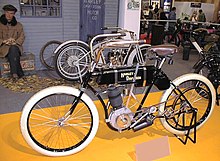
The prototype of the new loop-frame Harley-Davidson was assembled in a 10 ft × 15 ft (3.0 m × 4.6 m) shed in the Davidson family backyard.[11][12] Most of the major parts, however, were made elsewhere, including some probably fabricated at the West Milwaukee railshops where oldest brother William A. Davidson was toolroom foreman. This prototype machine was functional by September 8, 1904, when it competed in a Milwaukee motorcycle race held at State Fair Park. Edward Hildebrand rode it and placed fourth in the race.[11]
In January 1905, the company placed small advertisements in the Automobile and Cycle Trade Journal offering bare Harley-Davidson engines to the do-it-yourself trade. By April, they were producing complete motorcycles on a very limited basis. That year, Harley-Davidson dealer Carl H. Lang of Chicago sold three bikes from the five built in the Davidson backyard shed. Years later, the company moved the original shed to the Juneau Avenue factory where it stood for many decades as a tribute.
In 1906, Harley and the Davidson brothers built their first factory on Chestnut Street (later Juneau Avenue),[13] at the current location of Harley-Davidson's corporate headquarters.[14]The first Juneau Avenue plant was a 40 ft × 60 ft (12 m × 18 m) single-story wooden structure. The company produced about 50 motorcycles that year.

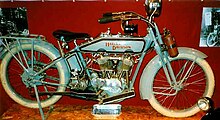
In 1907, William S. Harley graduated from the University of Wisconsin–Madison with a degree in mechanical engineering. That year, they expanded the factory with a second floor and later with facings and additions of Milwaukee pale yellow ("cream") brick. With the new facilities, production increased to 150 motorcycles in 1907. The company was officially incorporated that September. They also began selling their motorcycles to police departments around this time, a market that has been important to them ever since.[15] In 1907, William A. Davidson quit his job as tool foreman for the Milwaukee Road railroad and joined the Motor Company.
Production in 1905 and 1906 were all single-cylinder models with 26.84-cubic-inch (440 cc) engines. In February 1907, they displayed a prototype model at the Chicago Automobile Show with a 45-degree V-Twin engine. Very few V-Twin models were built between 1907 and 1910. These first V-Twins displaced 53.68 cubic inches (880 cc) and produced about 7 horsepower (5.2 kW). This gave about double the power of the first singles, and top speed was about 60 mph (100 km/h). Production jumped from 450 motorcycles in 1908 to 1,149 machines in 1909.[16]

In 1911, the company introduced an improved V-Twin model with a displacement of 49.48 cubic inches (811 cc) and mechanically operated intake valves, as opposed to the "automatic" intake valves used on earlier V-Twins that opened by engine vacuum. It was smaller than earlier twins but gave better performance. After 1913, the majority of bikes produced by Harley-Davidson were V-Twin models.
In 1912, Harley-Davidson introduced their patented "Ful-Floteing Seat", which was suspended by a coil spring inside the seat tube.[17] The spring tension could be adjusted to suit the rider's weight, and more than 3 inches (76 mm) of travel was available.[18] Harley-Davidson used seats of this type until 1958.[19]
By 1913, the yellow brick factory had been demolished and a new five-story structure had been built on the site which took up two blocks along Juneau Avenue and around the corner on 38th Street. Despite the competition, Harley-Davidson was already pulling ahead of Indian and dominated motorcycle racing after 1914. Production that year swelled to 16,284 machines.

World War I
In 1917, the United States entered World War I and the military demanded motorcycles for the war effort.[20] Harleys had already been used by the military in the Pancho Villa Expedition[21][22] but World War I was the first time that it was adopted for military issue, first with the British Model Hproduced by Triumph Motorcycles Ltd in 1915.[23] The U.S. military purchased over 20,000 motorcycles from Harley-Davidson.[24]
Harley-Davidson launched a line of bicycles in 1917 in hopes of recruiting more domestic customers for its motorcycles. Models included the traditional diamond frame men's bicycle, a step-through frame 3–18 "Ladies Standard", and a 5–17 "Boy Scout" for youth. The effort was discontinued in 1923 because of disappointing sales.[25] The bicycles were built for Harley-Davidson in Dayton, Ohio by the Davis Machine Company from 1917 to 1921, when Davis stopped manufacturing bicycles.[26]
1920s
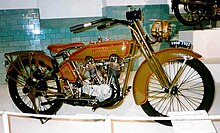
By 1920 Harley-Davidson was the largest motorcycle manufacturer in the world, with 28,189 machines produced and dealers in 67 countries.[27] In 1921, Otto Walker set a record on a Harley-Davidson as the first motorcycle to win a race at an average speed greater than 100 mph (160 km/h).[28][29]
Harley-Davidson put several improvements in place during the 1920s, such as a new 74 cubic inch (1,212.6 cc) V-Twin introduced in 1921, and the "teardrop" gas tank in 1925. They added a front brake in 1928, although only on the J/JD models.[30] In the late summer of 1929, Harley-Davidson introduced its 45-cubic-inch (737 cc) flathead V-Twin to compete with the Indian 101 Scout and the Excelsior Super X.[31] This was the "D" model produced from 1929 to 1931.[32] Riders of Indian motorcycles derisively referred to it as the "three cylinder Harley" because the generator was upright and parallel to the front cylinder.[33] In 1929, Vivian Bales drove a record 5,000 miles across the United States and Canada on a D-model.[34]
Great Depression
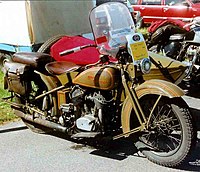
The Great Depression began a few months after the introduction of their 45 cu in (740 cm3) model. Harley-Davidson's sales fell from 21,000 in 1929 to 3,703 in 1933. Despite this, Harley-Davidson unveiled a new lineup for 1934, which included a flathead engine and Art Decostyling.[35]
In order to survive the remainder of the Depression, the company manufactured industrial powerplants based on their motorcycle engines. They also designed and built a three-wheeled delivery vehicle called the Servi-Car, which remained in production until 1973.[31]

Alfred Rich Child opened a production line in Japan in the mid-1930s with the 74 cu in (1,210 cm3) VL. The Japanese license-holder, Sankyo Seiyaku Corporation, severed its business relations with Harley-Davidson in 1936 and continued manufacturing the VL under the Rikuo name.[36]
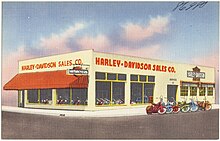
An 80 cubic inches (1,300 cm3) flathead engine was added to the line in 1935, by which time the single-cylinder motorcycles had been discontinued.[37]
In 1936, the 61E and 61EL models with the "Knucklehead" OHV engines were introduced.[38]Valvetrain problems in early Knucklehead engines required a redesign halfway through its first year of production and retrofitting of the new valvetrain on earlier engines.[39]
By 1937, all Harley-Davidson flathead engines were equipped with dry-sump oil recirculation systems similar to the one introduced in the "Knucklehead" OHV engine. The revised 74 cubic inches (1,210 cm3) V and VL models were renamed U and UL, the 80 cu in (1,300 cm3) VH and VLH to be renamed UH and ULH, and the 45 cu in (740 cm3) R to be renamed W.[38]
In 1941, the 74-cubic-inch "Knucklehead" was introduced as the F and the FL. The 80 cu in (1,300 cm3) flathead UH and ULH models were discontinued after 1941, while the 74-cubic-inchU & UL flathead models were produced up to 1948.[38]
World War II

One of only two American motorcycle manufacturers to survive the Great Depression (the other being the Indian Motorcycle Manufacturing Company),[40][41]Harley-Davidson again produced large numbers of motorcycles for the US Army in World War II and resumed civilian production afterwards, producing a range of large V-twin motorcycles that were successful both on racetracks and for private buyers.
Harley-Davidson, on the eve of World War II, was already supplying the Army with a military-specific version of its 45 cubic inches (740 cm3) WL line, called the WLA. The A in this case stood for "Army". Upon the outbreak of war, the company, along with most other manufacturing enterprises, shifted to war work. More than 90,000 military motorcycles, mostly WLAs and WLCs (the Canadian version) were produced, many to be provided to allies.[42] Harley-Davidson received two Army-Navy "E" Awards, one in 1943 and the other in 1945, which were awarded for Excellence in Production.
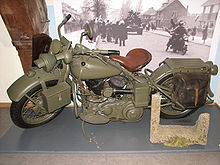
Shipments to the Soviet Union under the Lend-Leaseprogram numbered at least 30,000.[43] The WLAs produced during all four years of war production generally have 1942 serial numbers. Production of the WLA stopped at the end of World War II, but was resumed from 1950 to 1952 for use in the Korean War.
The U.S. Army also asked Harley-Davidson to produce a new motorcycle with many of the features of BMW'sside-valve and shaft-driven R71. Harley-Davidson largely copied the BMW engine and drive train and produced the shaft-driven 750 cc 1942 Harley-Davidson XA. This shared no dimensions, no parts or no design concepts (except side valves) with any prior Harley-Davidson engine. Due to the superior cooling of the flat-twin engine with the cylinders across the frame, Harley's XA cylinder heads ran 100 °F (56 °C) cooler than its V-twins.[44] The XA never entered full production: the motorcycle by that time had been eclipsed by the Jeep as the Army's general-purpose vehicle, and the WLA – already in production – was sufficient for its limited police, escort, and courier roles. Only 1,000 were made and the XA never went into full production. It remains the only shaft-driven Harley-Davidson ever made.
